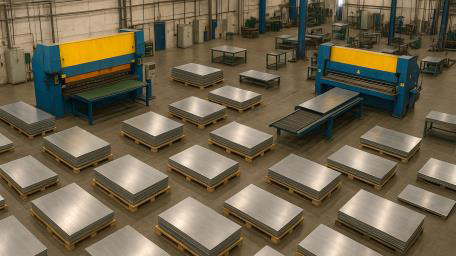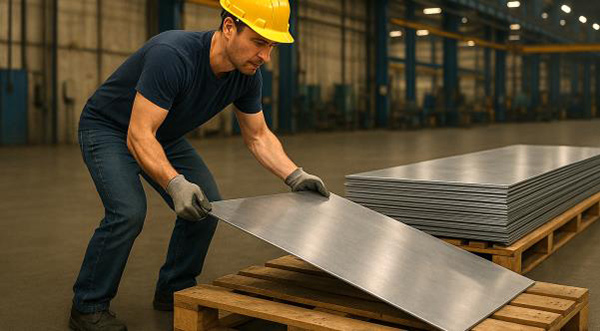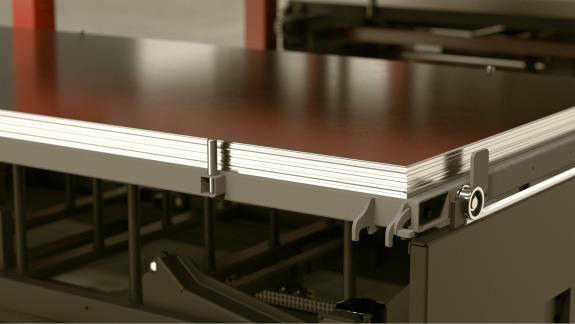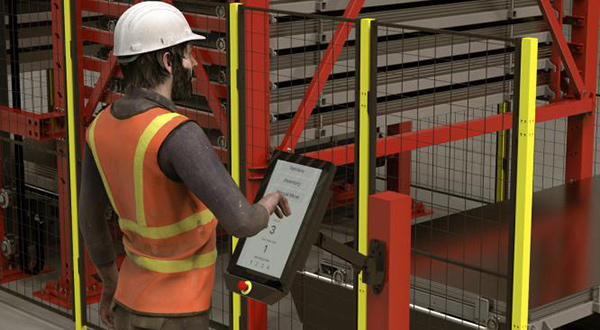How automated sheet metal storage transforms manufacturing, unlocking faster retrieval and safer workflows with unparalleled flexibility.
By Ryan O’Donnell, Sales Representative at Vidir
Manufacturers today face a dilemma that seems impossible: how to increase sheet metal storage without expanding floor space. The conventional methods of stacking metal on the floor or relying on cantilever racks are still common, but they come with hidden costs. Traditional racking and floor stacking eat up valuable square footage, force operators to hunt for materials, and expose workers to the risks of heavy overhead lifts. Retrieval times can stretch to six minutes per pick, tying up two employees and slowing production. The result is a system that consumes valuable square footage while slowing productivity and elevating risk.
Forward-looking manufacturers are rethinking storage as more than a static necessity. By storing vertically, automating retrieval, and consolidating material into one centralized system, facilities can reclaim up to 80 percent of their floor space and cut retrieval times to less than a minute. The result is not just higher density, but a safer, faster, and more cost-effective way to handle one of the most essential inputs in modern manufacturing.

The inefficiencies of traditional racking systems become painfully clear in facilities where operators must sift through multiple racks or floor stacks just to locate a part. What seems like a small delay adds up quickly; even an extra three to five minutes per pick can amount to several lost hours over the course of a shift. Multiply that by two or three shifts a day, and the result is hundreds of hours of wasted labor each month that could have been directed toward value adding work.
This disorganization also comes at a premium. Forklift drivers are often the highest paid employees on the floor, and when they spend their time ferrying wide, unwieldy sheets across the plant, costs rise without any real increase in productivity. OSHA regulations compound the expense by requiring spotters when heavy sheets (typically weighing more than 2,500 pounds) are lifted, meaning two employees are tied up for every retrieval.
Traditional racking and OSHA regulations demand spotters for hefty lifts, so manufacturers routinely assign two employees per pick. The reduced headcount achievable with automation translates directly into measurable labor savings, particularly when calculated across multiple shifts. In practice, this means that what should be a quick material move often consumes double the labor at double the cost- a reality automation is specifically designed to solve.

Beyond the inefficiencies, the risks are substantial. Forklifts are poorly suited for handling wide, flat sheets, and the danger increases with height. Loads lifted 15 to 20 feet in the air can destabilize, and a single dropped sheet, often weighing several thousand pounds, could cause catastrophic damage to both people and equipment. To mitigate this, some facilities impose strict limits on how high such loads can be lifted, but these restrictions only slow operations further. For companies striving to balance productivity with worker well-being, the time drain, labor costs, and safety risks inherent in older storage methods are increasingly unsustainable.
An effective high density storage solution should maximize sheet capacity without requiring additional square footage. Tower configurations have emerged as a leading answer, with dual tower configurations consolidating a double-wide storage capacity into a single system, serviced by one lift. By eliminating redundant components and optimizing lift design, manufacturers can store up to 68 cartridges of sheet metal each holding 5,000 to 6,600 pounds in less than 280 square feet. That level of density reclaims as much as 80 percent of floor space compared to traditional methods, creating room for more production equipment and smoother workflows.
Speed of retrieval is just as important. In many plants, picking a single order can take six minutes or more, as workers search through multiple racks and coordinate with forklifts. Automated systems transform this process, bringing the requested sheet to ground level at the push of a button. Retrieval times shrink to under a minute and the certainty of knowing every SKU resides in one centralized machine eliminates delays and reduces frustration. These systems also protect materials by minimizing contact points, preserving surface quality for high-spec industries like aerospace and defense.

Equally critical are features that adapt to the demands of modern production. Configurable trays must accommodate standard formats such as 4′ x 8′, 5′ x 10′, and 6′ x 12′, as well as oversized sheets. Heavy duty tower designs can support loads up to 450,000 pounds in total system capacity, while servo-driven lifts and chain drive systems ensure smooth motion and reduced wear.
Customization not only spans tray sizes and load capacities, but also interfaces: automated storage systems can be configured to integrate seamlessly with a facility’s existing ERP software, supporting tailored workflows and production layouts. With all systems made-to-order, customers select rear, front, or lateral cart access and software integrations to match facility needs, keeping automation as future-ready and scalable as their business.
Integrated safety features such as fencing, light curtains, and redundant braking systems provide layers of protection, creating ergonomic ground level access points and eliminating the hazards associated with forklifts.
When safety and productivity are treated as complementary goals rather than competing ones, the impact is transformative. Reducing forklift traffic decreases the likelihood of accidents while simultaneously lowering labor costs. Facilities running multiple shifts often discover that cutting down on forklift usage not only improves safety but also eliminates the expense of multiple operators and spotters.
One manufacturer’s experience illustrates the power of such a solution. Before transitioning to an automated dual-tower system, their average pick time was six minutes and required two employees, using 1,750 square feet. After the upgrade, retrieval took just 57 seconds and could be completed by one operator, occupying just 300 square feet. This shift resulted in daily labor savings totaling 34.83 hours; equivalent to $818.51 per day, $4,092.55 per week, and $212,784 annually, based on a typical $23.50 hourly wage. Combined with $15,950 in annual floor space savings, the total yearly savings reached $228,734, yielding a payback period of only 1.5 years. Freed resources could then be directed to higher value tasks.

Vidir, a North American leader in automated storage solutions, has helped facilities achieve precisely these kinds of outcomes. The company’s dual tower system is engineered to deliver high- density capacity in a compact footprint, supported by servo-driven motors and modular tray design that adapt to evolving production needs. Customers have reported significant improvements in both throughput and safety, with reclaimed space and reduced forklift dependency driving measurable ROI.
For facilities adopting these solutions, access to 24/7 service support and rapid on-site technician response ensures minimized downtime and high reliability, especially for multi-shift operations. Manufacturers appreciate shorter lead times compared to industry averages, with locally built systems often delivered in nearly half the time required for European imports. With these advantages, Vidir has established itself as a reliable partner for manufacturers seeking to modernize their storage infrastructure.
The future of sheet metal storage is moving toward even deeper integration with factory automation. Autonomous guided vehicles and app-based controls are poised to make material retrieval fully synchronized with production lines. But even today, manufacturers adopting dual- tower vertical lift systems are gaining an advantage. By doubling storage capacity without expanding their footprint, streamlining retrieval to under a minute, and embedding safety into every operation, they are creating facilities that are not only more efficient but also more resilient. For companies navigating the pressures of global competition, the ability to store smarter is becoming just as important as the ability to produce faster.
In this episode, I sat down with Beejan Giga, Director | Partner and Caleb Emerson, Senior Results Manager at Carpedia International. We discussed the insights behind their recent Industry Today article, “Thinking Three Moves Ahead” and together we explored how manufacturers can plan more strategically, align with their suppliers, and build the operational discipline needed to support intentional, sustainable growth. It was a conversation packed with practical perspectives on navigating a fast-changing industry landscape.